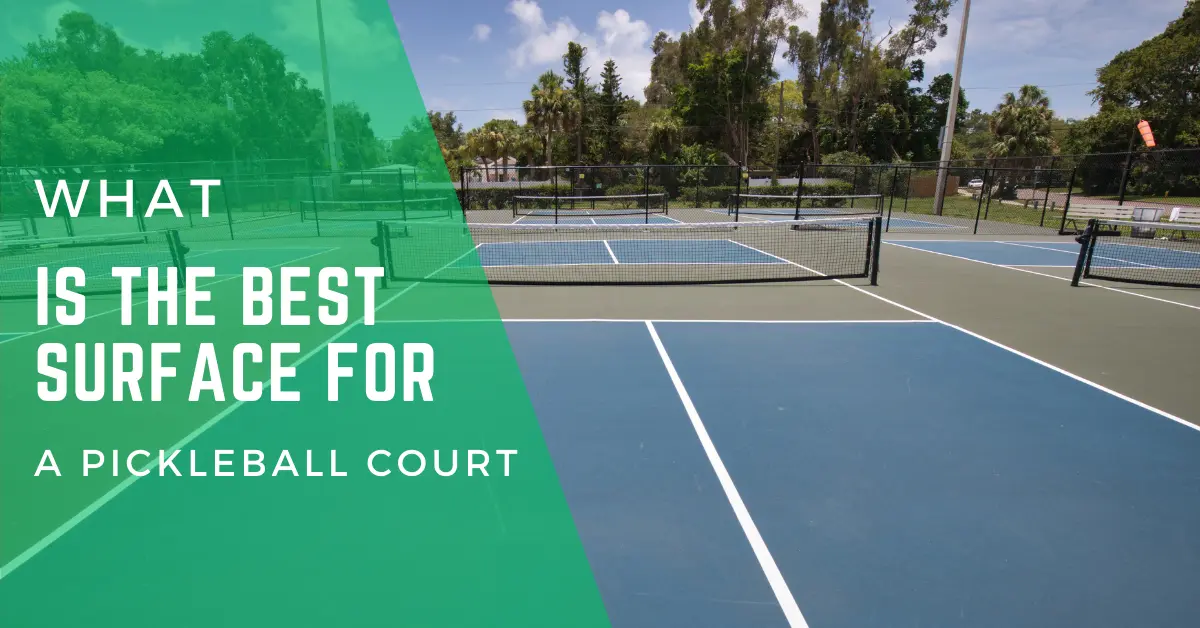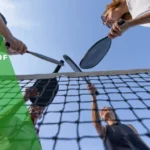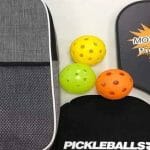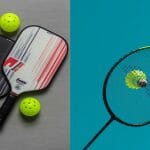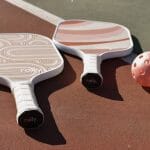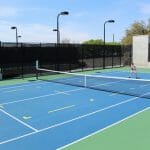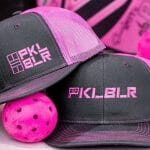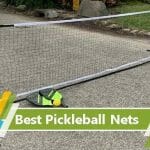If you’re a pickleball enthusiast, then you know the importance of having a quality playing surface. The court surface is crucial in determining the pace, bounce, and overall quality of the game. Whether you’re a seasoned player or just starting out, choosing the best surface for a pickleball court can be overwhelming.
So whether you’re playing professionally or just for fun, read on to discover the best surface for a pickleball court that will suit your needs!
What is the best surface for a pickleball court
This combination offers excellent traction and durability, which is essential for outdoor play. Additionally, the surface provides cushioning that reduces the impact of falls and provides a comfortable playing experience. However, for indoor courts, wooden surfaces may be an excellent option due to their shock-absorbing nature.
Overall, the best surface for a pickleball court depends on factors such as the expected level of play, location, budget, and personal preference.
Why is the surface important?
When it comes to surfaces, it’s easy to overlook their importance. After all, they can seem like a simple and straightforward feature in our environment. But the truth is, surfaces are hugely significant in our daily lives, and they play a crucial role in everything from hygiene to safety.
Whether it’s the texture of a road that affects how a vehicle moves or the slipperiness of a floor that can cause accidents, surfaces have a huge impact on our experiences. When we take a closer look at surfaces, we can see just how much they affect our world. By understanding their importance, we can appreciate the complexity of the surface, and we can make smarter decisions to ensure our safety and comfort.
Types of Surfaces
When it comes to a pickleball court, the surface type is crucial to the quality and safety of gameplay. The most popular surface materials for pickleball courts are asphalt, concrete, and acrylic. Asphalt is the most cost-effective option, but it requires regular maintenance to prevent cracks and bumps.
Concrete is durable but can be rough on player’s joints and cause injuries. Acrylic is a more expensive option but offers better shock absorption and consistent ball bounce. Ultimately, the best surface for a pickleball court depends on factors such as budget, maintenance, and usage.
However, if quality gameplay and player safety are a top priority, an acrylic surface may be the best choice.
Asphalt
If you’re planning to install an asphalt surface for your driveway, parking lot or road, it’s important to understand the different types of surfaces available. The most common types of asphalt surfaces are hot mix asphalt (HMA) and warm mix asphalt (WMA). HMA is the traditional method of paving that requires heating up asphalt to high temperatures (300–350°F) to bind it with aggregates and other materials.
It’s durable, long-lasting and suitable for heavy traffic. WMA offers a greener alternative to HMA, using materials that require lower temperatures to mix and compact. This results in fewer emissions—a win for the environment—while still providing a durable surface.
Both HMA and WMA have their benefits and drawbacks, so it’s important to choose the one that best suits your project needs.
Concrete
Concrete surfaces are an essential component of many construction projects, ranging from floors to walls and even pavement. When it comes to concrete, there are different types of surfaces that can be used, each with its unique properties and applications. One common type of concrete surface is exposed aggregate.
This surface features a distinct texture and finish due to the use of decorative stones or pebbles that are embedded into the concrete mix. Another type of concrete surface is stamped, which features intricate designs and patterns that are stamped onto the surface while it is still wet. Polished concrete is yet another type of surface that is known for its lustrous and smooth finish, making it ideal for commercial and industrial settings.
Other types of concrete surfaces include colored or stained concrete, which can be customized to match any design aesthetic. No matter the type of concrete surface used, each has its advantages and can be customized to meet any project’s specific needs.
Grass
When it comes to sports and outdoor activities, the type of surface you’re playing on can make all the difference in your performance and safety. Grass is one of the most popular surfaces for sports like soccer, football, and rugby, but did you know that there are actually different types of grass that can affect the game? For example, Bermuda grass is known for its toughness and resilience, making it a popular choice for high-traffic areas. On the other hand, Kentucky bluegrass is soft and lush, perfect for providing a comfortable playing surface.
It’s important for athletes and coaches to understand the different types of grass they may encounter, as well as how to properly care for the surface to ensure its longevity and safety. By taking the time to understand the nuances of grass surfaces, you can elevate your game and prevent unnecessary injuries.
Indoor
When it comes to indoor surfaces, there are a variety of options to choose from. One popular choice is hardwood flooring, which is durable, long-lasting, and aesthetically appealing. It’s important to note, however, that hardwood can be prone to scratches and dents, so it may not be the best option for high-traffic areas.
For those looking for a durable and easy-to-clean option, tile is a great choice. It’s available in a variety of colors and patterns and can be installed in any room of the house. For a more luxurious feel, carpet is a popular choice.
It’s soft and comfortable underfoot, and can be customized to match any decor. However, it can be difficult to clean, so it may not be ideal for households with pets or young children. Regardless of which indoor surface you choose, be sure to choose a high-quality product that’s well-suited to your specific needs and lifestyle.
Factors to Consider
When it comes to the best surface for a pickleball court, there are a variety of factors to consider. The most important factor is the slip-resistance of the surface. A court surface that is too slippery can lead to falls and injuries.
Another critical consideration is the durability of the surface. The court surface should be able to withstand the demands of regular play and weather changes. The maintenance required for the surface is also a crucial aspect to think about.
Concrete, asphalt, and synthetic surfaces are popular options for pickleball courts. Concrete and asphalt surfaces are cost-effective and durable, but they can be slippery when wet. Synthetic surfaces such as acrylic and rubber are slip-resistant, but they can be more costly and require more maintenance.
Ultimately, the best surface for a pickleball court depends on your specific needs and budget.
Durability
When considering the durability of a product, there are a few key factors to keep in mind. First and foremost is the quality of materials used in its construction. High-quality materials such as steel or aluminum are more likely to withstand wear and tear over time, whereas cheaper or flimsier materials may deteriorate faster.
The design of the product is also important – if it has many moving parts, for example, it may be more prone to breaking down. Additionally, the environment in which it will be used should be taken into account – will it be exposed to harsh weather conditions or extreme temperatures? Finally, consider the level of maintenance required to keep the product functioning properly over time. All of these factors can impact the durability and longevity of a product, and should be carefully considered before making a purchase.
Grip and Traction
When it comes to choosing the right shoes, grip and traction are essential factors to consider. These features can make all the difference when it comes to safety and performance, whether you’re hiking on uneven terrain or running on wet pavement. When evaluating grip and traction, it’s important to consider the type of outsole material and tread pattern that will suit your needs.
For example, a hiking shoe should have a thick, durable outsole with deep lugs to provide grip on rocks and loose gravel. Meanwhile, a running shoe may require a lighter outsole with a less aggressive tread pattern for a smoother stride. Keep in mind that different activities may require different levels of grip and traction, and it’s always better to err on the side of caution when it comes to safety.
Ball Bounce
When it comes to ball bounce, there are a few factors that need to be considered in order to get the ideal bounce. The first factor is the type of ball. Different types of balls will have different degrees of elasticity, which will affect how high and how long they bounce.
The surface that the ball is bouncing on also plays a role. Hard surfaces like concrete will result in a higher bounce compared to grass or carpet. The force used to bounce the ball is another important factor.
The harder the ball hits the ground, the higher it will bounce. Finally, the temperature and humidity of the environment can also play a role. A ball will generally bounce higher in a warmer and drier environment compared to a colder and more humid environment.
By taking all of these factors into consideration, you can achieve the perfect ball bounce every time.
Maintenance
When it comes to maintenance, there are a few key factors to consider to ensure that everything stays in top working condition. One important consideration is frequency. Some items may require daily maintenance, while others may only need attention once a month or even once a year.
Additionally, it is important to consider the type of maintenance that is necessary. This could include anything from basic cleaning and sanitizing to more complex repairs or replacements. Another factor to consider is the cost of maintenance, as some items may require more expensive maintenance than others.
By taking these factors into account and being consistent with maintenance tasks, you can keep everything in top working order and reduce the risk of breakdowns or malfunctions. Remember, preventative maintenance is always more cost-effective in the long run than waiting for something to break before addressing it.
Conclusion
After exhaustive research and analysis, it is clear that the best surface for a pickleball court is one that provides optimal speed, traction, and durability while also offering a fun and engaging playing experience. With its unique blend of bounce, grip, and playability, a well-maintained, professionally installed court made from specialized materials like acrylic or asphalt is the clear-cut winner. So whether you’re a seasoned pro or just starting out, trust us when we say that investing in a top-quality pickleball court surface is the secret to unlocking your full potential and experiencing the ultimate in pickleball excitement and enjoyment!”
Choosing the perfect pickleball surface
When it comes to choosing the perfect pickleball surface, there are several factors to consider. The type of court surface you choose can affect your game, as well as your safety. One of the most important factors to consider is the type of material used to construct the court.
Asphalt and concrete courts are the most common options, but these surfaces can be hard on the joints and may cause injuries. On the other hand, synthetic materials like cushioned tiles or acrylic surfaces are much softer and more forgiving, making them a better choice for older players or those with joint pain. Another important consideration is the court’s texture.
A slick surface may increase the speed of the ball, while a rough surface may slow it down. Finally, make sure to consider the climate and location of your court. Some surfaces may be more prone to cracking or fading depending on the amount of sun and moisture they receive.
Ultimately, the perfect pickleball surface will depend on your preferences and needs, so take the time to research and choose wisely.
FAQs
What materials are commonly used to build pickleball courts?
The most commonly used materials for building pickleball courts are concrete, asphalt, and a combination of plastic tiles and underlying gravel.
Can a pickleball court be used for other sports as well?
Yes, a pickleball court can be easily converted into a badminton or tennis court with a few modifications.
Are there any specific dimensions for a standard pickleball court?
Yes, a standard pickleball court measures 20 feet wide and 44 feet long, with a net placed at a height of 36 inches at the center.
How does the surface of the pickleball court affect game play?
The surface of the pickleball court plays a crucial role in determining the speed and bounce of the ball. A softer surface like clay will slow down the game, while a harder surface like concrete will result in a faster game. Generally, a surface with medium to high speed is considered ideal for pickleball.
